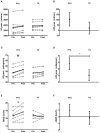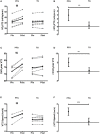Functional Exercise Training and Undulating Periodization Enhances the Effect of Whole-Body Electromyostimulation Training on Running Performance
- PMID: 29951003
- PMCID: PMC6009337
- DOI: 10.3389/fphys.2018.00720
Functional Exercise Training and Undulating Periodization Enhances the Effect of Whole-Body Electromyostimulation Training on Running Performance
Abstract
The popularity of whole-body electromyostimulation is growing during the last years, but there is a shortage of studies that evaluate its effects on physical fitness and sport performance. In this study, we compared the effects of a periodized and functional whole-body-electromyostimulation training on maximum oxygen uptake (VO2max), ventilatory thresholds (VT1 and VT2), running economy (RE), and lower-body muscle strength in runners, vs. a traditional whole-body-electromyostimulation training. A total of 12 male recreational runners, who had been running 2-3 times per week (90-180 min/week) for at least the previous year and had no previous experience on WB-EMS training, were enrolled in the current study. They were randomly assigned to a periodized and functional whole-body-electromyostimulation training group (PFG) (n = 6; 27.0 ± 7.5 years; 70.1 ± 11.1 kg; 1.75 ± 0.05 m) whose training program involved several specific exercises for runners, or a traditional whole-body-electromyostimulation training group (TG) (n = 6; 25.8 ± 7.4 years; 73.8 ± 9.8 kg; 1.73 ± 0.07 m), whose sessions were characterized by circuit training with 10 dynamic and general exercises without external load. The training programs consisted of one whole-body electromyostimulation session and one 20-min running session per week, during 6 weeks. The PFG followed an undulating periodization model and a selection of functional exercises, whereas the TG followed a traditional session structure used in previous studies. Both groups were instructed to stop their habitual running training program. VO2max, VT1, VT2, RE, and lower body muscle strength (vertical jump) were measured before and after the intervention. The PFG obtained significantly higher improvements when compared with the TG in terms of VO2max (2.75 ± 0.89 vs. 1.03 ± 1.01 ml/kg/min, P = 0.011), VT2 (2.95 ± 1.45 vs. 0.35 ± 0.85 ml/kg/min, P = 0.005), VO2max percentage at VT2 (5.13 ± 2.41 vs. 0.63 ± 1.61%), RE at VT1 (-7.70 ± 2.86 vs. -3.50 ± 2.16 ml/kg/km, P = 0.048), RE at 90% of VT2 (-15.38 ± 4.73 vs. -3.38 ± 4.11 ml/kg/km, P = 0.005), and vertical jump in Abalakov modality (2.95 ± 0.94 vs. 0.52 ± 1.49 cm, P = 0.008). Therefore, we conclude that running performance improvements were better after a 6-week program following an undulating periodization and consisting on functional exercises when compared with a 6-week traditional WB-EMS program.
Keywords: VO2max; VT2; WB-EMS; running economy; training periodization.
Figures




References
-
- Amaro-Gahete F. J., de la O. A., Jurado-Fasoli L., Ruiz J. R., Gutiérrez Á. (2017). Could superimposed electromyostimulation be an effective training to improve aerobic and anaerobic capacity? methodological considerations for its development. Eur. J. Appl. Physiol. 117, 1513–1515. 10.1007/s00421-017-3625-x - DOI - PubMed
LinkOut - more resources
Full Text Sources
Other Literature Sources
Miscellaneous

